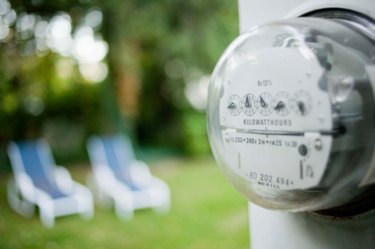Things You'll Need
Ohm's Law (E= IR)
P = IE
P( in kW) = I(in amperes) × V(in volts) / 1000
Pencil
Paper
Calculator

There is a relationship between current, resistance, voltage and the work done by an electric circuit. All these factors work together in the circuit to safely convey electrical energy throughout the house. It takes current to do work. Power, measured in watts, is the work done by the flowing of current through the circuit for a specific amount of time. Power is obtained by dividing the work done by the time, giving units of watt-hours. The prefix "kilo" means 1000, so power delivered to a home is measured in 1000 watt-hours or kilowatt-hours.
Step 1
Find out what the required current for the circuit is. The first piece of information needed is the current (I), which is measured in a unit called amps. Current can be found by using Ohm's Law. For example, if the voltage and resistance are known for an appliance, the current can be found by dividing the voltage (E) or (V) by the resistance (R). If Power is known in watts but resistance is not, we can determine the current used by dividing the power by the voltage and get the current in amps. For example a 100-watt lamp using 120-volts carries a current of 100(W) / 120 (V) = 0.8333 amps.
Video of the Day
Step 2
Obtain the voltage ratings. Some appliances will work with 110-volts, while others will need 220-volts. In most commercial buildings and enterprise facilities, the voltage may go up to 277, 480 or even 600-volt lines. Most homes use the 110 and 220-volt lines. The value of the voltage also can be obtained if power and current are known by dividing power (P) by current (I) and getting the value in volts.
Step 3
Substitute the values obtained from step 1 and 2 in the equation: P(kW) = I(A) × V(V) / 1000. For example, for a motor that is 3.5-amps and needs 120-volts to operate, the power can be calculated as following: multiply the current in amps by the voltage in volt to get the power consumed: 3.5amp x 120V = 420 watts/hour. Divide this value by 1000 (which what kilo stands for) to obtain the value in kWh. So 420 / 1000 is equal to 0.420 kWh. If this motor runs for 5 hours, then the power consumption in kW for 5 hours will be 0.420 x 5 = 2.1 kWh. If a utility company charges $0.14 for 1 kilowatt/hour, then you would end up paying them 2.1 x $0.14 = 29 cents for those five hours.
Video of the Day